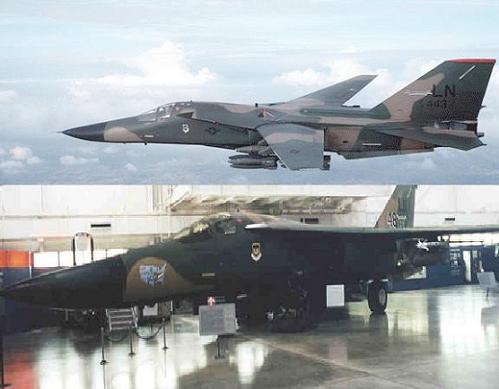Yoram Mizrachi

Above: The main model of the plane. Below: The crow model used for electronic warfare
Direct link to this page: https://www.hayadan.org.il/yh030904.html
These days, the Australian Ministry of Defense announced that in 2010, 35 F 111 multi-purpose attack aircraft, produced by General Dynamics/USA, were decommissioned. These are aircraft that stand out with "variable geometry wing" technology, which has characterized only a few aircraft in the history of American aviation (for example, the F-14 Tomcat, which continues to undergo improvements and even goes up, as needed, on a production line) The variable geometry allowed the aircraft, for example, the ability to take off and land from short runways , when the pilot sets the angle of the wings from 16 degrees to 72 degrees and the "arrowhead" configuration.
Other innovations included a special cockpit, which is used as an escape and rescue cabin for the pilot and navigator. The cabin detaches from the plane and descends when intact, with the ability to land and float on water and in it "air bags" to cushion and soften the landing. The Royal Australian Air Force RAAF successfully operates the supersonic aircraft, which at the time was considered revolutionary, even after the last F-111s that were still kept in the US were mainly used for training and testing systems, until they were sent to "deep storage" at the Davis Mountain base in Arizona, a step that is the last step before they are scrapped. Taking the aircraft out of service in the US allows For the Australians to rely on a huge stockpile of spare parts, which are transferred to it by the "cannibalization" method of disabled tools.
Australia plans to further refresh and upgrade its fleet of F/A-18 Hornet aircraft, numbering 71 aircraft, to equip them with systems that will allow "stretching of operational service" at least until the year 2020 and especially to equip them with new weapons systems, which will give the Australian Air Force a "long muscular arm" The plan is based on Purchased advanced AMRAAM (medium-range air-to-air missile) and ASRAAM (short-range air-to-air missile) missiles and mainly equipped with cruise missiles of new models, with a range of about 400 km and "stealth" capability. The cruise missiles being tested in preparation for the procurement decision, which is expected in early 2005, are produced by Boeing, Martin-Grumman or the German company Taurus. The total investment in the procurement of all weapon systems will exceed the billion dollar (US) line. The new cruise missiles will be adapted, among other things, for carrying and launching As part of the armament of the Orion PC-3 long-range maritime patrol aircraft, ten of which are in Australian service and marked for advanced upgrade.
Alongside the Australian plan, which is being criticized by the opposition from the House calling to "extend the life of the F-111" as well as in the regional diplomatic arena, for example the opposition of Indonesia, (the Islamic giant with 249 million inhabitants compared to the 20 million Australians) a country that warns against a "spatial arms race" that provokes the future of the F-111 is an interest among military aviation experts, who stand on the historical dimension, related to the end of the journey of the plane that participated, among other things, in the Vietnam War starting in 1968 (from bases in Thailand) in Operation Desert Storm as well as in the bombing of Libya by the American Air Force in 1986 (in response " to the Sirte Bay incident" and the Libyan Air Force's attempt to intercept American planes) the planes were also involved in the operations in Granada and Panama.
The F-111 aircraft, for its various models, was developed in the early 111s, as commissioned by the US Air Force and Navy, but the Navy withdrew from the program and the model developed for it, the F-2.2D, was the one that was eventually built for the Australians. The planes excel in supersonic flight at the height of the waves, with a record speed of Mach 111 and the ability to penetrate at low altitude, while "skimming treetops and terrain routes". The F-60 is able to soar up to a height of 4000 feet and fly, without detachable tanks, for a range of XNUMX kilometers, carrying, or on racks, a variety of armaments, one of the models including nuclear weapons. One of the more interesting models of the plane is the "Crow" a dedicated plane for electronic warfare and disabling adversary N.M. systems.
The US Air Force's decision to disable the aircraft comes after the successes in the development of the F-16 models and future fighter jets that will soon enter service and their demonstrated ability to "take over" most of the F-111's missions.
Also in the fields of electronic warfare and more, so are various models of the F-15 "and the backbone aircraft" of the Australian Air Force F/A-18.
Associations and veterans of operational service in the F-111 that operate websites and information centers point out the high level of safety of the plane, which, despite its variable geometry wing, is considered one of the safest in the history of the Air Force, as well as the penetration capability, which relies on advanced systems to identify a ground route at the lowest altitude and immediate flight response and sensitivity according to the information scanned and recorded. Pilots and navigators, who operated the plane during the Vietnam War, say that the plane "did not disappoint and kept pilots alive" all this except for operational praise and the description of the achievements. Attacks, reconnaissance and disruption of electronic systems. While Australia prepares to use its F-111 aircraft for at least another six years, American aircraft have been transferred to aviation museums and joined a long line of military aircraft that have finished their duty and were a nostalgic asset.
https://www.hayadan.org.il/BuildaGate4/general2/data_card.php?Cat=~~~941542516~~~184&SiteName=hayadan
